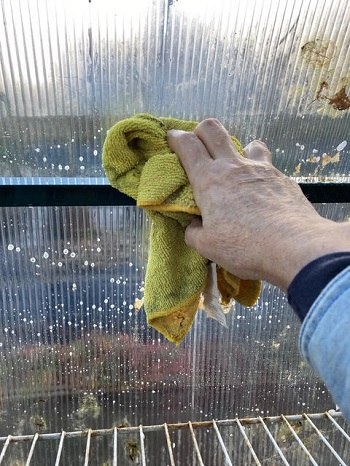
Your climate control system is checked and ready to go. It may be cold outside, but in your greenhouse, it’s warm, slightly humid, and a paradise for your plant life. Congratulations! You’re all set to grow throughout the cold season. There’s only one small issue: your humid greenhouse is now the hottest place in town for pests and diseases.
You’ve probably heard of the term “Spring Cleaning” but with greenhouses, the most important cleaning happens in the fall before winter hits. October is a great month to start the cleaning process, as the weather is still (usually) temperate and dry. To begin, you will want to move your plants outside of the greenhouse. All plants should be kept outside of the greenhouse while cleaning is occurring—the same chemicals you use to get rid of mold and algae can be harmful to your plants. Additionally, removing your plants and their respective containers removes any hiding places. Whiteflies, fungus gnats, and various types of molds love to nestle into dark crevices and secluded corners.
Start by cleaning out the inevitable debris that finds its way onto the greenhouse floor during a growing season. A simple broom will work just fine, but an industrial vacuum can make cleaning much more efficient. Start at the top of your greenhouse, focusing on window ledges, rafters, and the roof so debris falls to the floor. If your greenhouse contains an irrigation system, clean it now to remove all dirt and biofilm. Finally, squeegee or wipe down the inside and outside surfaces of your greenhouse windows. While using water, make sure that any electric outlets in your greenhouse are fully covered. After the top is clean, sweep or vacuum the floor, then dispose of the collected debris.
Any wood in the greenhouse can be a hotbed for pests and plant pathogens. Wood, unless specially treated during manufacturing to resist disease, should not be present in a greenhouse. However, if you have untreated wood in your greenhouse, now is the time to disinfect it. Disinfectants are not permanent. They will usually kill diseases, but they offer no extended protection from disease.
Disinfectants that use hydrogen peroxide or hydrogen dioxide are environmentally friendly ways to sanitize your greenhouse. Hydrogen peroxide is used to kill algae and should not be used while plants are in the greenhouse. Follow label instructions for proper use. Hydrogen dioxide can be used while plants are present in the greenhouse, but all surfaces should be wetted before application. However, it is still best to remove plants before sanitizing the greenhouse. Extended exposure or overexposure to hydrogen dioxide can cause phytotoxicity in some plants, and plant containers still prevent you from disinfecting every area of your greenhouse. Disinfectants using hydrogen dioxide terminate a wide variety of bacteria or fungi. After using disinfectants, leave the greenhouse open to ensure residual chemicals do not remain trapped in the greenhouse.
The important thing to remember when it comes to cleaning is that prevention is much easier than eradication. Taking some simple steps to thoroughly clean and disinfect your greenhouse before you heat it throughout the winter can prevent existing pathogens and pests from establishing themselves. Additionally, using sticky pest traps allows you to monitor your greenhouse and stay ahead of any pests. If you’re starting new plants in the winter, the safest move is to quarantine them, so infections don’t spread in your humid greenhouse.
For information on greenhouse maintenance, and to view climate-controlled greenhouses that are easy to clean and maintain, check out ArcadiaGlassHouse.com.
Joshua Nichols is the MyGardenAndGreenhouse.com associate editor.
Related Articles & Free Email Newsletter
A Beginners Guide to Grow Lights
How to Extend your Vegetable Harvest into Winter



Comment here